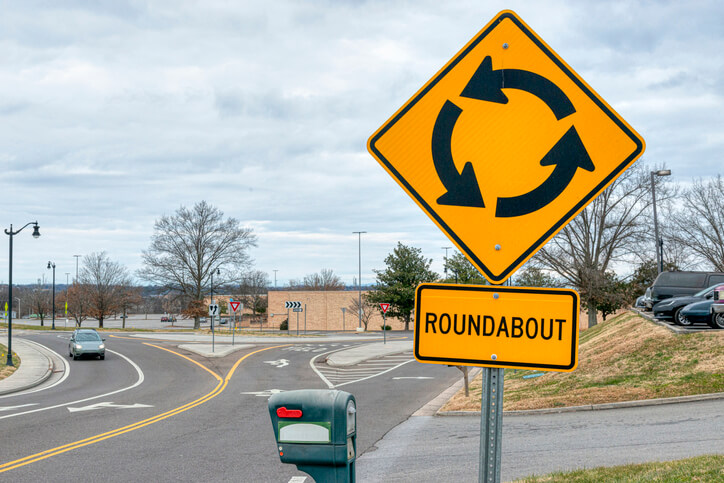Roundabouts, or traffic circles, were first developed over in the United Kingdom in the 1960s, but are now widely used across the world, including in the U.S. It is, essentially, a circular intersection where cars yield upon entering. The design is intended to foster efficient traffic flow as well as make intersections safer. If you haven’t had much experience or exposure with roundabouts, however, the unfamiliar design may be daunting. Here, we will discuss some of the safety benefits and challenges that come with roundabouts.
Safety Benefits and Challenges of Roundabouts
Roundabouts are often used at intersections that have a history of high crash rates or large traffic delays. The vehicles travel around counterclockwise and the curved design pushes vehicles to slower speeds. Once in the roundabout, drivers proceed to the exits they are needing. The design of the roundabout makes it innately safer than other, traditional intersections that use traffic signals and stop signs to manage traffic flow.
Think about it. At a traffic signal, you avoid many of the most common types of intersection crashes. There are no right-angle or left turn crashes. Head-on collisions, while possible, are very unlikely to occur. Traditional intersections are also far easier to speed through, which makes these types of crashes extra dangerous. With a roundabout, the vehicles travel in the same direction at reduced speeds. This means that the common crash types at traditional intersections are nearly eliminated and that crashes are likely to be less severe due to lower speeds.
Roundabouts have also proven to be safer for pedestrians as well as motorists. As pedestrians walk around the sidewalks which line the perimeter of the traffic circle, they only need to cross lanes of one direction of traffic at a time, since all drivers are moving in the same direction. Additionally, the crossing of lanes is usually shorter and the vehicles are traveling at lower speeds than they would be at traditional intersections.
As you can see, roundabouts have many safety benefits and generally provide an overall safer space for vehicles and pedestrians than that which is afforded by the traditional intersection model. Nothing, of course, is infallible. Roundabouts present their own challenges despite being generally safer than the traditional intersection. Merging, for instance, can create confusion. Conflicts regarding who has the right of way could lead to crashes. Some of the more common types of roundabout crashes include:
- Vehicles being run off the road
- Vehicles being sideswiped
- Vehicles failing to yield the right of way when entering the circular path of the roundabout
- Vehicles colliding with the central island
Most of these common roundabout crash types of stem from failure to yield the right of way and traveling at unsafe speeds in the traffic circle. In multilane roundabouts, the merging and high speeds can be even more of an issue, particularly for motorists who are not familiar with the traffic pattern presented by a roundabout.
Philadelphia Personal Injury Attorneys
Have you been injured in a motor vehicle accident? Do not hesitate to call the dedicated personal injury attorneys at Cooper, Schall & Levy. Contact us today.


